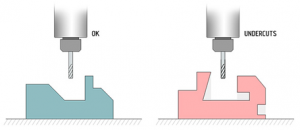Our workshop leader offers these detailed answers to frequently asked questions on CNC machining.
What are the limits of CNC machining?
CNC machining machines are digital milling machines which are limited with regard to the shapes they can create. Firstly, they cannot machine the areas that are not available in the natural sense of machining, i.e. the areas that the milling machine cannot access without turning the part. We call these zones undercuts. It is then necessary to cut and assemble the areas of the part by gluing to create these shapes in an undercut. Some radii or sharp angles are not feasible because the milling cutter is too big. A milling cutter leaves a minimum machining radius. In general, we use radii of 0.5 to 1 mm.
In addition, the size of CNC machining parts also impacts their creation. Parts that are too big must be cut into several pieces which are then glued. On the other hand, parts that are very small with tight tolerances are difficult to hold.
Finally, a part with overly complex shapes (e.g. comprising a large number of undercuts) is not feasible with plastic CNC machining because it would be necessary to create too many small pieces to glue. For this type of project, it is appropriate to switch to vacuum casting technology.
What are the materials that you principally use in CNC machining?
We principally use ABS for plastic CNC machining projects with few technical constraints. This material offers a combination of properties (high rigidity, strength and insulation capacity, etc.) allowing it to have a wide field of use. However, prototypes including standards to be respected, strong constraints or specific applications require different materials. For example, we principally use PP for creating hinges.
Regarding metals, for CNC machining projects of metal parts, our workshop principally uses aluminum. This metal is particularly strong and lightweight. In addition, it provides good conductivity and is easily machinable. Steel is the second most used metal by our team. Its hardness is higher and it is very resistant to shocks. Several steel alloys are available.
How to choose the material for my CNC machining project?
In CNC machining, we offer the main families of plastic materials. They offer different properties. The material is chosen according to the technical constraints of parts and their final use. Our workshop is able to assist you in the selection of materials to meet your specifications. Here are some examples of recommendations to ensure certain properties:
- Transparent plastic parts are feasible with PC and PMMA
- We recommend ABS for projects without specific constraints
- PP offers good mechanical strength, resistance to shock and bending
- POM allows a spring effect and provides good rigidity
- PA 6 exhibits good resistance to wear and mechanical stress
- PVC is relatively resistant to acids, shocks, and weather

